By Wallace Wyss
One of the best things about the Palos Verdes Concours, which takes place at the Trump National Golf Club, is that it is on a peninsula that sticks out into the Pacific. The view is to die for–rolling golf greens and limitless ocean.
Not only that, it seems they have a tradition there of honoring obscure French marques. This year, though, the overall theme was “Age of Elegance” with examples of Rolls-Royce, Bentley, Duesenberg, and Dietrich coachwork. Ray Dietrich was a celebrated American designer in the custom coachwork era.
But rest assured there were plenty of Italian and French cars.
This year they had the return of the Facel Vegas and this writer was especially impressed with a Facel II. It really makes you wonder, how a company building a car that looked that good can fail, but I suppose it had to do with the failure of their small four cylinder car, the Facillia, also shown. All the 1st, 2nd, and 3rd place winners in the Facel class were older FV body styles but perhaps they were better restored than the author’s favorite, the Facel II.
It was announced that there would be a French-bodied BMW 507 there, the one designed by French-born American resident Raymond Loewy, who did the similar-looking Avanti for Studebaker, but if it was there I missed it. Fortunately it is occasionally shown by its owner, the Petersen Museum in Los Angeles.
BROCK HONORED
There was also a display honoring Peter Brock, the now 70-ish American designer who went to work at GM at age 19 as a trainee. While at GM Brock worked on a clay model called the Q-Corvette that later on influenced the Sting Ray race car, which in turn evolved into the 1963 Corvette. Brock has recently published a book on that era in the Corvette development. He is much more famous for the Cobra Daytona coupe which he designed from start to finish, and even produced a replica bearing his name.
Also displayed at the Brock display was a Fantuzzi-bodied DeTomaso Group 7 car, the 70P, in rough body shape. I have never seen this car with the body off but imagine the spine frame is in rough shape as well. The showing of DeTomaso race car prototype around various shows this year marks the ascendancy of this marque into respectable ranks of vintage racers. Ironically, back when your author was writing books on DeTomaso cars it was damned difficult to find any listings of actual race placings by DeTomaso race cars (other than the Pantera Group 4 cars). That car won the Motor Trend Classic Award. Its owner was also showing a very clean Iso Grifo A3C race car, about which I hope to document in the future.
In antique French cars the Hispano Suiza town car was outstanding as a representative of the good life in Europe before the Second World War. It was Kellner-bodied in the laudaulette style. It won “Best of Show” where it had to beat the Duesenberg “Twenty Grand” from the Nethercutt Museum, not an easy task.
Absolutely stunning was the 1951 Talbot Lago T26 cabriolet from the Mullin Museum. This car had the right color—black—with a dark maroon cloth convertible top. It has, in this writer’s eyes, the exact amount of brightwork. Not too much. Not too little. It’s a pity that model didn’t better known as the company could have survived. It won first in Postwar European Luxury.
In European grand touring 1946-1972, Peter McCoy’s 1951 Ferrari 212 Vignale coupe took first. This two tone green and black car really is a fine jewel of a car, particularly the letter “I” on the rear trunk lid which stands for Italy but also looks like it lights up. It beat two Mercedes 300SLs, a gullwing taking second, and a roadster taking third.
Daniel Cytrynowics won second place for his ’51 Siata Daina Grand Sport 1400, which was done in two-tone, black and yellow. I also appreciated the fire engine class, which had one with a boiler that I forgot to ask if it was steam powered. I think this is part of the function of a concours—to introduce a new class each year to give those who come every year to the show something new to see. I should also add they had a few American hot rods honoring dry lakes racing and the beginnings of the hot rod. I didn’t get over to see them but hot rodding is in my roots—I’m from Detroit and you can take the boy out of Detroit but not the Detroit out of the boy.
For those who haven’t been to the Pebble Beach Concours and wonder what you missed, this is a sort of preview of what you would see there—same ocean, same greens, but a lot less crowded. There were also some vendor’s booths, and a posh dining room in the golf course clubhouse, so there’s many of the same elements as you find at the Pebble Beach Concours.
I was told they have over 250 volunteers for the event, which benefits the Palos Verdes Art Center and the Palos Verdes Peninsula Rotary Foundation. Their work shows– it is an elegantly-staged event and I look forward to next year.
THE AUTHOR: Wallace Wyss was also a vendor at the event, signing his book Incredible Barn Finds, available from Enthusiast Books, Hudson, WI. Read Review and order from Amazon.com.
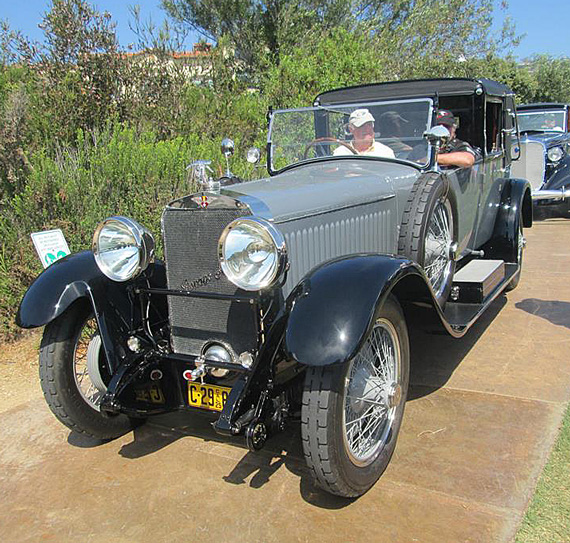
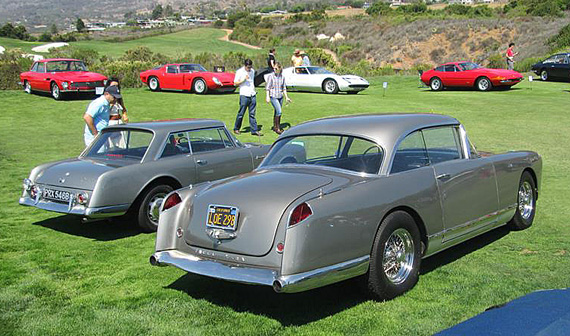
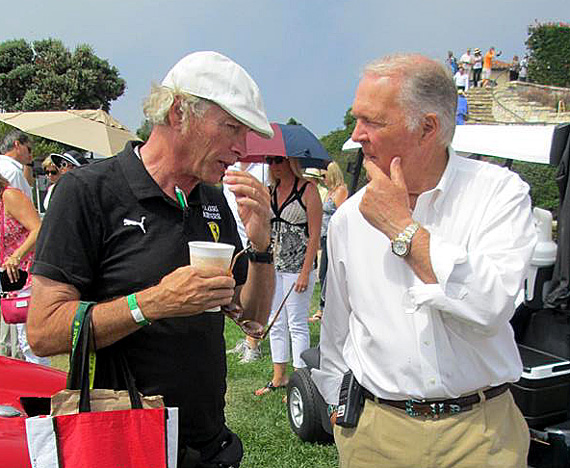
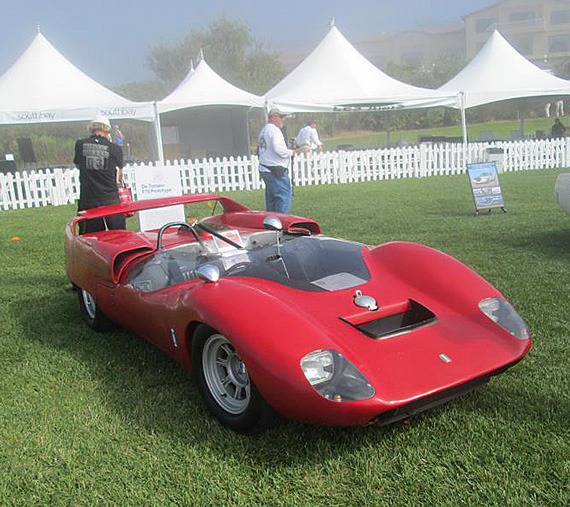
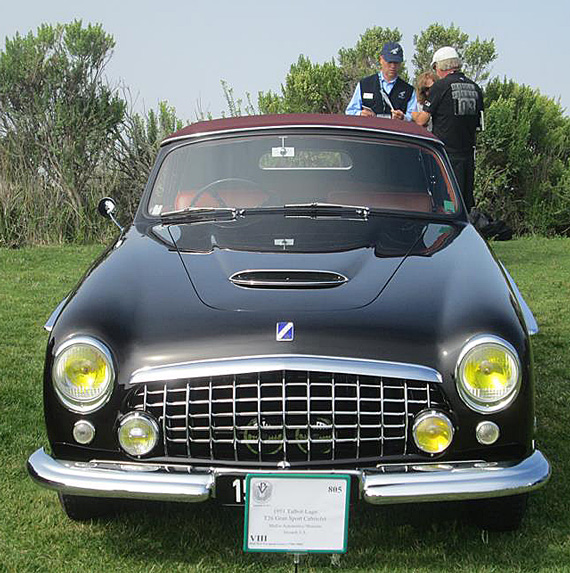
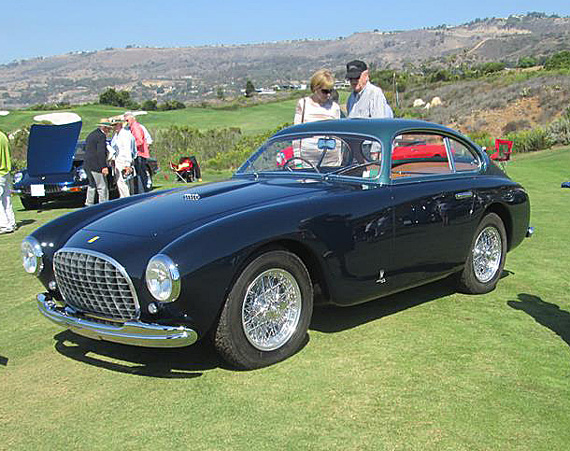
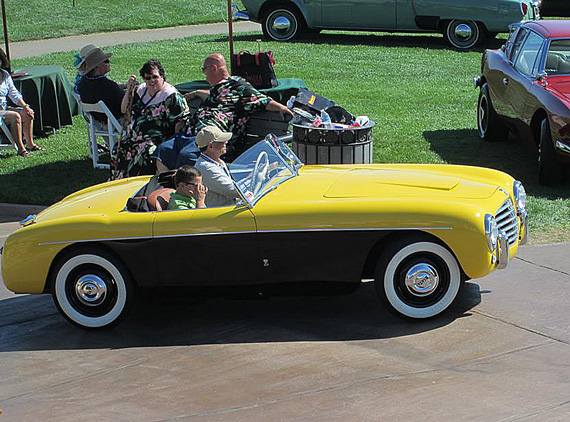
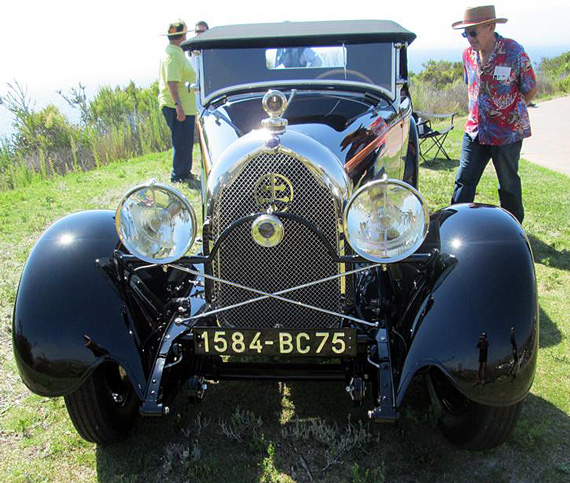
The Hispano-Suiza is a 1925 H6B cabriolet de ville by Kellner.
The 1951 Talbot Lago cabriolet Grand Sport is a one-off automobile designed and built by Stabilimenti Farina in Torino. The Portuguese owner of that chassis # 110160, commisioned 10 other carrossiers with design proposal, and Farina was choosen. After completion, the owner requested stabilimenti Farina to destroy design and pattern in order that no other body could be built like this one. In October 1951, racing driver Guiseppe Farina, (and co-owner with his brother Attilio of stabilimenti Farina) drove this car from Torino to the Salon de l’Automobile de Paris, to be exposed on the Talbot-Lago stand. The car was “bianco latte” with red leather interior. Wire wheels were painted white as well, but Talbot CEO replaced the wheels by chromed ones.
Blue and white logo in front should read: “Automobiles LAGO, made by Talbot S.A. Paris”, instead of “Automobiles TALBOT Suresnes”. This is due to the agreement between the London-based TALBOT company and Antony Lago upon his take-over of the Paris factory, allowing him to use the Talbot name in various countries. But the Iberian peninsula was completely forgotten, thus forcing LAGO to revert this stratagem for the 2 or 3 cars sold to Portugal. Original owner kept the car until 1985, when my friend Jacques Touzet from Lisbon kept it until 2000, before going to the USA.
This colour is totally wrong and not nice (to me…)